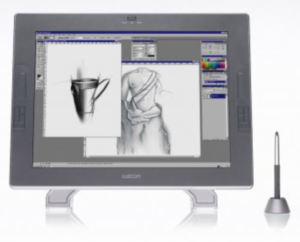Graphic pen input company Wacom (Saitama, Japan) recently announced it’s latest line of integrated pen LCD tablets with support for UHD displays in both 24″ and 32″ diagonal screen sizes.

The technology, more popularly known as the Cintiq in graphic arts circles, is offering a display size boost from the current Pro models shipping today in 13″ (2560 x 1440) and 16″ diagonal sizes. The 16″ (ok it’s a 15.6″) Pro model is currently a 3840 x 2160 UHD resolution display. Both new models are being pre-announced (why again?) with $2,000 and $3,300 price tags, respectively, targeting an early 2018 ship date.
Interestingly, early versions of the Cintiq have been around since the 1992 (Yikes, 25 years!) when I was the product manager for the technology at Wacom. The product is probably much older than the majority of its trendy millennial users ever imagined, yet it still finds functionality today in animation, web design and other creative digital outlets.
More recent version of the Cintiq LCD Pen Tablet from WacomThe genesis of this still relevant display technology goes back to the days of early pen computing and forgotten hardware and software O/S with names like Go Corp.’s Pen Point operating system, AT&T’s EO running a proprietary microprocessor chip called the Hobbit, and Aha Software’s Ink Writer – a gesture-based ink writing application, just to mention a few. Then big boy on the street, Microsoft, got interested and developed it’s Windows for Pen Computing. Once the space was validated by the giant from Redmond, the game changed forever, and it seemed that every laptop brand needed to ship a pen computer and its must-have, language agnostic, handwriting recognition software.
The first line of Wacom integrated PL- (short for pen-LCD) products was really a commercialized version of an engineering reference design / SDK that was made in partnership with Sharp Microelectronics. It integrated a 9.x” Wacom sensor board (can’t remember the exact size here but Joel Pollack of Samsung PenTile fame and Amazon, ran the division.) This LCD tablet component from Sharp, combined with the Wacom pen, was the genesis of many of those first pen tablets that appeared on the scene. I have memories of attending trade shows (like SID’s Display Week) in support of the Sharp booth.
We were more of a gadfly to the giant display company, as folks with no intention of buying a display from Sharp would line up clogging the booth, wanting to try their hand on the pen tablet component and it’s (not too accurate) handwriting recognition software. (Joel, can you ever forgive me?) But overall under Joel’s leadership, Sharp was quite successful with that product shipping LCD’s to perhaps more than half of the pen-computers of that era.
 Image of first commercial LCD Pen Tablet From 1993 Popular Science Article
Image of first commercial LCD Pen Tablet From 1993 Popular Science Article
As a commercial product, LCD tablet’s first iteration came in the form of the PL-100V, an engineering name lost to obscurity, that shipped with a video card encased ‘black box’ along with driver firmware (or a slightly cheaper video card version with software) to help translate the gestures and pressure data from the battery-free pen to serial and video data ports. The result was an integrated pen input system that displayed real-time drawing on the mirrored image display. That was quite a feat for the X86 architecture with sub-Mb RAM and the video graphics cards and interfaces of the day.
In short, we’ve come a long way since the pen-LCD days of the 90’s. From those early efforts, a still relevant product can find a place in today’s world of iPhones, Siri (and Alexa) and touch gesture, tablet swipes dominate. Go figure… Stephen Sechrist
Samsung Introduces New Notebook 9 Pro, a Slim and Powerful PC with Embedded S Pen
What Happened to Non-Digital Displays?

